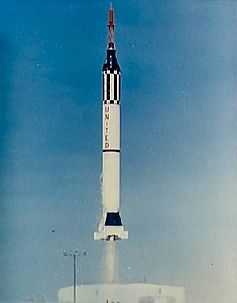Mercury-Redstone 1A
|
|
|
| Mission type |
Test flight |
|---|
| Operator |
NASA |
|---|
| Mission duration |
15 minutes, 45 seconds |
|---|
| Distance travelled |
378.2 kilometers (235.0 mi) |
|---|
| Apogee |
210.3 kilometers (130.7 mi) |
|---|
|
|
| Spacecraft properties |
|---|
| Spacecraft |
Mercury No.2 |
|---|
| Manufacturer |
McDonnell Aircraft |
|---|
| Launch mass |
1,230 kilograms (2,720 lb)[1][note 1] |
|---|
|
|
| Start of mission |
|---|
| Launch date |
December 19, 1960, 16:15 (1960-12-19UTC16:15Z) UTC |
|---|
| Rocket |
Redstone MRLV |
|---|
| Launch site |
Cape Canaveral LC-5 |
|---|
|
|
| End of mission |
|---|
| Landing date |
December 19, 1960, 16:30 (1960-12-19UTC16:31Z) UTC |
|---|
|
Mercury-Redstone 1A (MR-1A) was launched on December 19, 1960 from LC-5 at Cape Canaveral, Florida. The mission objectives of this unmanned suborbital flight were to qualify the spacecraft for space flight and qualify the system for an upcoming primate suborbital flight. The spacecraft tested its instrumentation, posigrade rockets, retro rockets and recovery system. The mission was completely successful. The Mercury capsule reached an altitude of 130 miles (210 km) and a range of 235 miles (378 km). The launch vehicle reached a slightly higher velocity than expected - 4,909 miles per hour (7,900 km/h). The Mercury spacecraft was recovered from the Atlantic Ocean by recovery helicopters about 15 minutes after landing. Serial numbers: Mercury Spacecraft # 2 together with the escape tower from Capsule # 8, and the antenna fairing from Capsule # 10 were reflown on MR-1A. Redstone MRLV-3 was used. Flight time 15 minutes 45 seconds.
Current location
Mercury spacecraft #2, used in both the Mercury-Redstone 1 and Mercury-Redstone 1A missions, is currently displayed at the NASA Ames Exploration Center, Moffett Federal Airfield, near Mountain View, California.[2]
Mercury-Redstone suborbital flight events

MR-1A Launch
| T+ Time |
Event |
Description |
|---|
| T+00:00:00 |
Liftoff |
Mercury-Redstone lifts off, onboard clock starts. |
| T+00:00:16 |
Pitch Program |
Redstone pitches over 2 deg/s from 90 deg to 45 deg. |
| T+00:00:40 |
End Pitch Program |
Redstone reaches 45 deg pitch. |
| T+00:01:24 |
Max Q |
Maximum dynamic pressure ~575 lb/ft² (28 kPa). |
| T+00:02:20 |
BECO |
Redstone engine shutdown - Booster Engine Cutoff. Velocity 5,200 mph (2.3 km/s) |
| T+00:02:22 |
Tower Jettison |
Escape Tower Jettison, no longer needed. |
| T+00:02:24 |
Capsule Separation |
Posigrade rockets fire for 1 s giving 15 ft/s (4.6 m/s) separation. |
| T+00:02:35 |
Turnaround Maneuver |
Capsule (ASCS) system rotates capsule 180 degrees, to heat shield forward attitude. Nose is pitched down 34 degrees to retro fire position. |
| T+00:05:00 |
Apogee |
Apogee of about 115 miles (185 km) reached at 150 miles (240 km) downrange from launch site. |
| T+00:05:15 |
Retrofire |
Three retro rockets fire for 10 seconds each. They are started at 5 second intervals, firing overlaps. Delta V of 550 ft/s (168 m/s) is taken off forward velocity. |
| T+00:05:45 |
Retract Periscope |
Periscope is automatically retracted in preparation for reentry. |
| T+00:06:15 |
Retro Pack Jettison |
One minute after retrofire retro pack is jettisoned, leaving heatshield clear. |
| T+00:06:20 |
Retro Attitude Maneuver |
(ASCS) orients capsule in 34 degrees nose down pitch, 0 degrees roll, 0 degrees yaw. |
| T+00:07:15 |
.05 G Maneuver |
(ASCS) detects beginning of reentry and rolls capsule at 10 deg/s to stabilize capsule during reentry. |
| T+00:09:38 |
Drogue Parachute Deploy |
Drogue parachute deployed at 22,000 ft (6.7 km) slowing descent to 365 ft/s (111 m/s) and stabilizing capsule. |
| T+00:09:45 |
Snorkel Deploy |
Fresh air snorkel deploys at 20,000 ft (6 km). (ECS) switches to emergency oxygen rate to cool cabin. |
| T+00:10:15 |
Main Parachute Deploy |
Main parachute deploys at 10,000 ft (3 km). Descent rate slows to 30 ft/s (9 m/s) |
| T+00:10:20 |
Landing Bag Deploy |
Landing Bag Deploys, dropping heat shield down 4 ft (1.2 m). |
| T+00:10:20 |
Fuel Dump |
Remaining hydrogen peroxide fuel automatically dumped. |
| T+00:15:30 |
Splashdown |
Capsule lands in water about 300 mi (500 km) downrange from launch site. |
| T+00:15:30 |
Rescue Aids Deploy |
Rescue aid package deployed. The package includes green dye marker, recovery radio beacon and whip antenna. |
Notes
- ↑ This is the mass of the spacecraft after separation from the booster, including all spacecraft consumables. It excludes the escape tower, which was jettisoned before spacecraft separation, and the spacecraft-booster adapter, which remained attached to the booster. Note that Mercury spacecraft #2 lacked some of the equipment present in the spacecraft used on the manned Mercury flights.
See also
References
 This article incorporates public domain material from websites or documents of the National Aeronautics and Space Administration.
This article incorporates public domain material from websites or documents of the National Aeronautics and Space Administration.
External links
|
|---|
| | General | | |
|---|
| | Contractors | |
|---|
| | Related programs |
|
|---|
| | Missions |
|
|---|
| | Astronauts |
General | |
|---|
| In order of flight | |
|---|
| Equipment | |
|---|
|
|---|
| | Test animals | |
|---|
| | Subprograms | |
|---|
| | Rockets | |
|---|
| | Launch sites and Control Center | |
|---|
| | Other |
- Mercury 13 (Non NASA project inspired by Project Mercury)
|
|---|
|



![]() This article incorporates public domain material from websites or documents of the National Aeronautics and Space Administration.
This article incorporates public domain material from websites or documents of the National Aeronautics and Space Administration.
